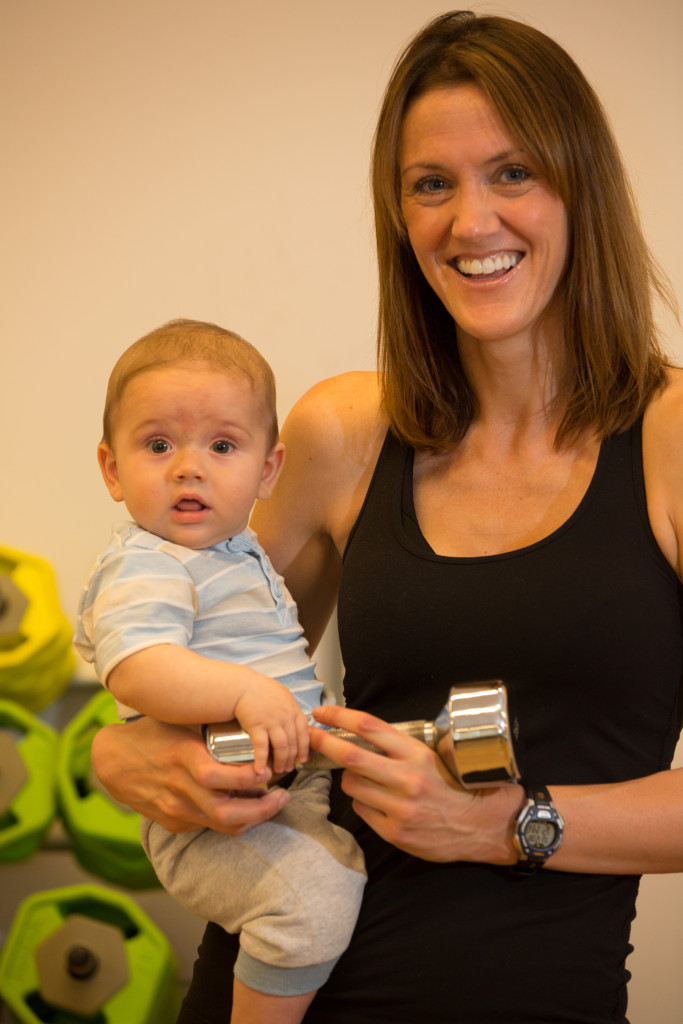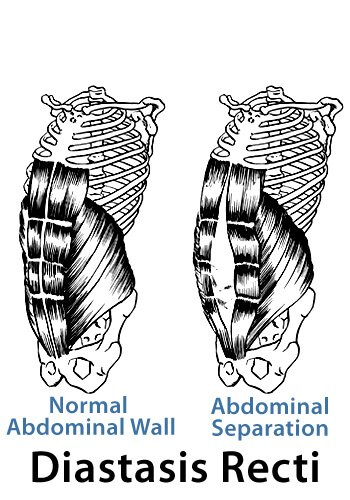Diastasis Recti Part 3 – Diastasis Recti Postpartum
Today’s topic? Diastasis Recti exercises (DR) postpartum.
Check out Diastasis Recti Part 1 for more information on what DR is and how and when to test for it. Additionally, Diastasis Recti Part 2 discusses how to limit diastasis recti during pregnancy. And now, our best DR postpartum tips and exercises!
Many of you requested a blog covering diastasis recti exercises post-birth. This is it!
Diastatsis Recti: An Brief Overview
Immediately after giving birth, most women experience some DR because the internal abdominal pressure of your growing baby that kept your belly nice and firm goes away. Sadly, your stomach muscles do not pull back immediately – your body is amazing, but that would be quite a feat!
So if you test for DR immediately after birth or even a couple of days after birth, the chances are you have DR. You can do the test at this point (and this is often when your doctor or midwife will check), but do remind yourself that you have just given birth and you need some time to heal. So don’t panic yet!
As discussed in the first part of this blog series, I recommend that you test 10-14 days after birth for a more accurate test result. Part 1 of this blog series discusses how to test for DR.
I do not suggest that until you do the test you do nothing and take no precautions! Every woman needs to work on firming up her core after a baby, even if any DR heals quickly. Pregnancy and labor puts a unique strain on your abdominals and your overall body. Even your organs shift to make room for the baby!
Before we discuss the exercises you can do let’s consider what you should avoid doing:

Diastasis Recti: Precautions
Post birth you need to continue to take the precautions to protect your core that you took during pregnancy. In Part 2 of this blog series I set out in detail my recommended precautions during pregnancy. Please read those guidelines again post birth!
Furthermore, post birth, you need to pay extra attention to how you sit up in bed or get up from the sofa when you hold your baby or breastfeed.
Do What I Say, Not What I Did
I know about DR, but when I had my first son I would initially often relax back against the headboard of the bed to breastfeed him because this was a comfortable way for him and I to feed. As he was in my arms I used my stomach muscles to get up. I also could not put my legs over the side of the bed as his crib was squeezed in next to me! So I would do a “crunch” to sit up to transfer my son to his crib. You also have a tendency to sit up quickly when they first cry to check all is ok and forget your own stomach. It’s amazing how from the moment they are born they come first and you start to forget looking after you!
I soon realized what I was doing, it felt like I had done hundreds of crunches and my stomach was starting to hurt, especially if he was up several times at night – which he was, every night, like most newborns!
What to do:
Try to use lots of pillows behind you as you lay in bed with your baby so that you are comfortable to feed, but you are able to sit up/get up without putting a huge strain on your abdominals. Think about the position of the crib too – maybe feed on your partner’s side of the bed (if they are not there!) so you have room to maneuver without also having to wiggle down the bed to put your feet down! Or try laying your baby down next to you after the feed so that you can get up comfortably and then pick your baby up. Although I appreciate that often moving a sleeping baby is difficult or impossible!!
Think about how you lift your baby too – especially if you are picking him or her up from a low position. Use your legs to squat down and think about activating your core as you pick the little one up. If your little one likes to be held while he/she naps, consider getting a wrap. I used a material wrap with my first son and it really helped distribute the weight and avoid any strain on my back and stomach.
Postnatal bands and taping
There is a big market in postnatal bands or taping to heal diastasis recti. My view on these products is that they can, in some cases, help, but it is important that you do not rely too heavily on them. If you wear a band all the time it is doing the work that your core should be doing. At some point you want to stop wearing the band.
Diastasis Recti Bands or Tapes: Suggestions
- Speak to a qualified physiotherapist that can fit any band properly (do not buy a waist clincher from the internet that simply squeezes your internal organs!) or a qualified medical practitioner that can show you the correct taping technique – there is a technique to it not just putting tape on your belly.
- Use the band or taping in moderation.
- In addition to wearing the band or taping, do your core exercises to heal and rebuild your core and its strength so that you do not have to continue to wear the band or tape!
Diastasis Recti: Postpartum Exercises
I know that you have a million and one things on your mind with a newborn. Add to that the lack of sleep and you will be in total survival mode. However, you do need to think about you and ensure that you are ok. Doing some basic core work early on is as important as thinking about your nutrition. If you can establish good health and wellbeing post birth, it helps you to look after your baby.
Everyone’s DR will take different periods of time to heal. For some it will heal in a matter of weeks. For others it might take months. If you did not realize you had DR until many months or perhaps years after giving birth to your baby do not fear – DR can still potentially be healed through exercise even if you start when your baby is older!
Seek medical attention if:
If you have pain, severe herniation or bulging around the belly button make sure that you do see a professional for advice. In some cases, unfortunately, medical intervention proves the only answer so if you have concerns do speak to your doctor or midwife or another specialist. This blog series cannot substitute for medical advice based on your particular case.
Exercise Levels:
It takes several levels of exercise to rebuild your core. The exercises you did pre-pregnancy may not be suitable for many months and you should not jump straight into them. Be wary of “mom workouts” on the Internet, intended for completely healed moms well past the initial postpartum stages. A good trainer informs you of the suitability of exercises, but many sell their product as mom friendly to get more followers. Even if the trainer sells mom workout packages that qualify as tummy safe, watch out when they post a workout of the day – these do not always stay safe too!
The initial exercises I recommend may seem as though they are too easy, particularly if you continued to be active through your pregnancy. You may be tempted to dive into the more advanced exercises, but DON’T! You need to go through the process and heal from the inside. If you exercised throughout your pregnancy and everything went smoothly with the birth you may be able to move through the stages quicker than others, but I would advise you still start at the beginning and work up. Everyone is different but for the first few weeks limi your cardio to walking. Running or high impact work is likely to have a negative effect on pelvic floor and all the good work you are doing to repair your core.
Remember that your pelvic floor is related to abdominals and so you should start doing your pelvic floor (or kegal) exercises as soon as 24 hours after the birth unless a doctor advises otherwise.
Stage One: Exercises to Heal DR
Unless the doctor advises otherwise, or the exercises cause pain, especially if you had a c-section, these exercises can be done within days of giving birth. Keep the sets and reps low when you begin. To start completing 1 set of 5-10 reps can be sufficient and all you feel up to doing. Always listen to your body. If you need a nap in the early days – take a nap!
Aim for 3 – 5 days a week of pelvic floor and gentle TVA work for the first 6 weeks after birth. You could also do the exercises that I demonstrated in part 2 of this blog as a stage 2 set of diastasis recti exercises! So that gives you 11 exercises to begin with!!
Watch out on my Instagram and Facebook accounts for my postpartum tummy program, which will be released in a couple of months (after I have had my baby and can record all the videos!).
By Claire Martin-Royle

Connect with BeyondFit Trainer Claire
If you would like to read more about Claire’s personal journey, or for more great tips on exercising in pregnancy and postpartum feel free to email Claire or follow her online.
Get your body back in just 12 weeks!
Need more help postpartum? If you’re ready to burn the baby fat and get your body back…check out our exclusive Beyond Baby Program and I’ll show you exactly how!
That’s right, if you’re a mom ready to GET YOUR BODY BACK (no matter how old your baby is), you’re in the right place. Click HERE and I’ll reveal how busy Moms like YOU can burn fat and get your body back – in less than 3 hours per week.

